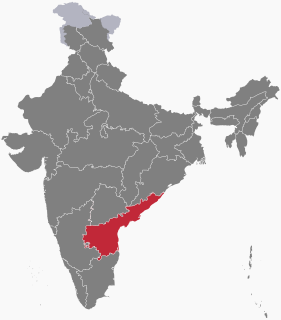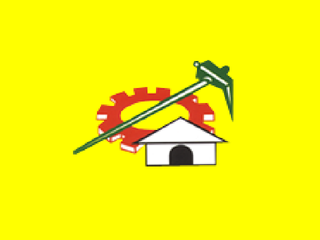Amalapuram Lok Sabha constituency is one of the 25 Lok Sabha constituencies in Andhra Pradesh state in southern India. This constituency is reserved for the candidates belonging to the Scheduled castes.
Bapatla Lok Sabha constituency is one of the 25 Lok Sabha constituencies of Andhra Pradesh in India and one among the three constituencies in the Guntur district of the state. This constituency is reserved for the candidates belonging to the Scheduled Caste.
In India, a certain number of political positions and university posts are held for specific groups of the population, including Scheduled Castes/Scheduled Tribes, Anglo-Indians and Women.

The first legislative assembly Election to the Madras state on the basis of universal adult suffrage was held in March 1952. This was the first election held in Madras state after the Indian Independence. This election was officially known as 1951 Madras State Election, even though through delays, actual voting didn't take place until early 1952.

The second legislative assembly election to the Madras state was held on 31 March 1957. This was the first election held after the linguistic reorganisation of Madras state in 1954. Indian National Congress and its leader K. Kamaraj won the election, and defeated its rival Dravida Munnetra Kazhagam. In 1954, due to the resignation of C. Rajagopalachari, for his controversial Kula Kalvi Thittam, the leadership of Congress was contested, between K. Kamaraj, and C. Subramaniam. Eventually, K. Kamaraj, won the support of the party, was elected leader and chief minister of Madras State in 1954. In a surprise move, he appointed both M. Bhaktavatsalam and C. Subramaniam, in his cabinet, allowing great unity amongst Congress, that ruled the state of Madras, for the next decade. This election saw future DMK leaders, M. Karunanidhi and K. Anbazhagan winning their first MLA seat in the legislative assembly.

The Andhra Pradesh Legislative Assembly election of 2009 took place in April 2009, concurrently with the Indian general election, 2009. The elections were held in the state in the first phase (2009-04-16) and second phase (2009-04-23). The results were declared on 2009-05-16. The incumbent Indian National Congress retained power in the Andhra Pradesh State Assembly lower house, though with a reduced majority. The Congress Legislature party re-elected incumbent Chief minister Y.S. Rajasekhara Reddy as its leader thus re-nominating him to the post. Thus, becoming the first politician to serve as Chief Minister of Andhra Pradesh in successive terms.

Elections in Andhra Pradesh state, India are conducted in accordance with the Constitution of India. The Assembly of Andhra Pradesh creates laws regarding the conduct of local body elections unilaterally while any changes by the state legislature to the conduct of state level elections need to be approved by the Parliament of India. In addition, the state legislature may be dismissed by the Parliament according to Article 356 of the Indian Constitution and President's rule may be imposed.

The Tamil Nadu Legislative Assembly alone has powers to legislate laws covering state subjects in the Indian state of Tamil Nadu. It has a strength of 235 members of whom 234 are democratically elected using the First-past-the-post system. The remaining member is nominated as a representative of the Anglo-Indian community. The presiding officer of the Assembly is called the Speaker. The term of the Assembly is five years unless it is dissolved earlier.
Khammam Assembly constituency is a constituency of Telangana Legislative Assembly, India. It is one of 10 constituencies in Khammam district.It includes the city of Khammam and part of Khammam Lok Sabha constituency.
Vijayawada West is a constituency of the Andhra Pradesh Legislative Assembly in India. It is one of 16 constituencies in the Krishna district of Andhra Pradesh and also one of the seven assembly segments of Vijayawada. As per the Delimitation Orders (1967), Vijayawada West was formed. It covers Vijayawada (urban) mandal (Part), Vijayawada (urban) (M.Corp) (Part), and Vijayawada (M.Corp) - Ward No.1 to 13, 15 to 19, 75 and 76.
Vijayawada East is a constituency of the Andhra Pradesh Legislative Assembly in India. It is one of 16 constituencies in the Krishna district of Andhra Pradesh. As per the Delimitation Orders (1967), Vijayawada East was formed. As per the Delimitation Orders (2008), the constituency covers Vijayawada (urban) mandal (Part), Vijayawada (urban) (M.Corp) (Part), Vijayawada (M.Corp) - Ward No. 32, 36 to 41, 45 to 48 and 50 to 74.
Nandigama Assembly constituency is an SC reserved constituency of the Andhra Pradesh Legislative Assembly, India. It is one among 16 constituencies in the Krishna district.
The Second legislative assembly of Madras state was constituted in April 1957 after the assembly election which held in March 1957.
The elections in India in 2014 include the Indian general election of 2014 and seven state legislative assembly elections. The tenure of the state legislative assemblies of Andhra Pradesh, Arunachal Pradesh, Haryana, Jammu and Kashmir, Maharashtra, Jharkhand, Odisha and Sikkim are due to expire during the year.
The Andhra Pradesh Legislative Assembly election, 2014 took place on 30 April and 7 May 2014 to elect members to the legislatures of Telangana and Andhra Pradesh. It was held concurrently with the Indian general election. The results were declared on 16 May 2014. The Telugu Desam Party led by N. Chandrababu Naidu won a majority of the 175 seats in the rump Andhra Pradesh, while Telangana Rashtra Samithi led by K. Chandrasekhar Rao won in the new state of Telangana.
Godam Nagesh, is an Indian politician. He hails from the Gond people.
Elections to the Andhra State Legislative Assembly were held on February 11, 1955. 581 candidates contested for the 167 constituencies in the Assembly. There were 29 two-member constituencies and 138 single-member constituencies.
Elections to the Andhra Pradesh Legislative Assembly were held on February 25, 1957. 319 candidates contested for the 85 constituencies in the Assembly. There were 20 two-member constituencies and 65 single-member constituencies.








